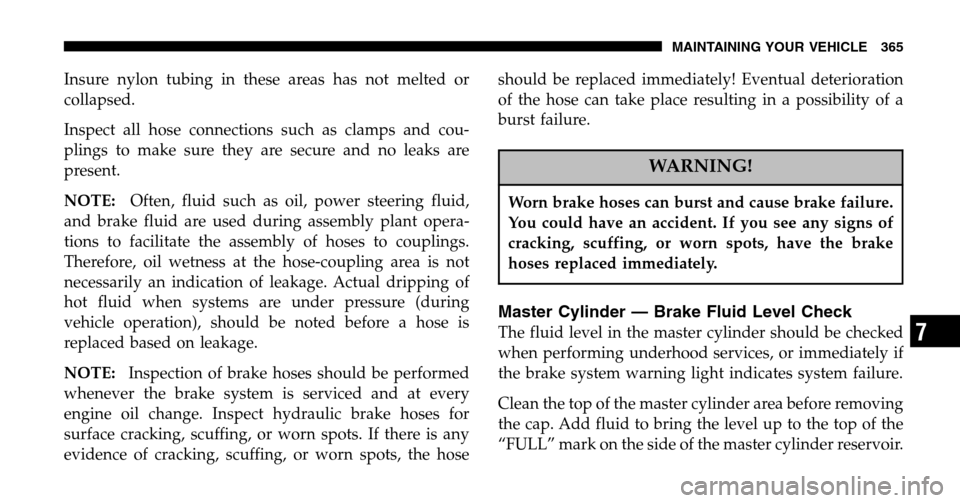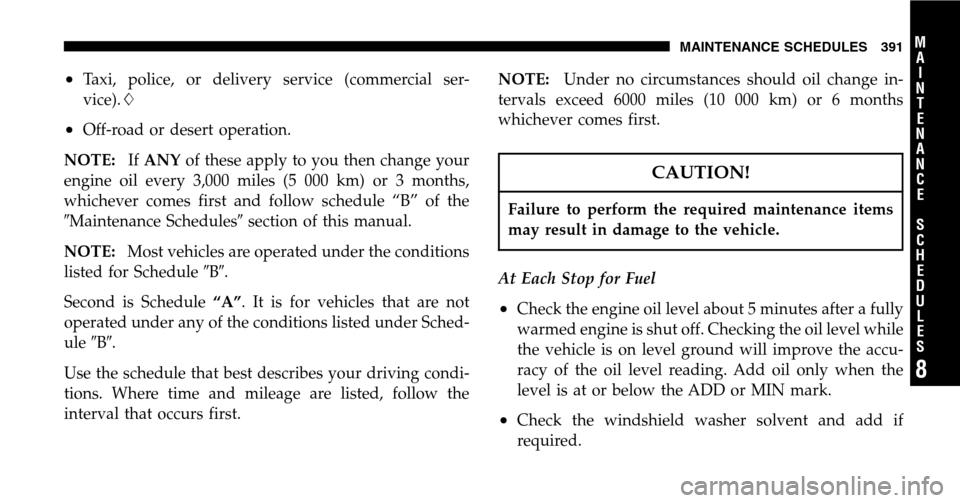Page 365 of 440

Insure nylon tubing in these areas has not melted or
collapsed.
Inspect all hose connections such as clamps and cou-
plings to make sure they are secure and no leaks are
present.
NOTE: Often, fluid such as oil, power steering fluid,
and brake fluid are used during assembly plant opera-
tions to facilitate the assembly of hoses to couplings.
Therefore, oil wetness at the hose-coupling area is not
necessarily an indication of leakage. Actual dripping of
hot fluid when systems are under pressure (during
vehicle operation), should be noted before a hose is
replaced based on leakage.
NOTE: Inspection of brake hoses should be performed
whenever the brake system is serviced and at every
engine oil change. Inspect hydraulic brake hoses for
surface cracking, scuffing, or worn spots. If there is any
evidence of cracking, scuffing, or worn spots, the hose should be replaced immediately! Eventual deterioration
of the hose can take place resulting in a possibility of a
burst failure.
WARNING!
Worn brake hoses can burst and cause brake failure.
You could have an accident. If you see any signs of
cracking, scuffing, or worn spots, have the brake
hoses replaced immediately.
Master Cylinder — Brake Fluid Level Check
The fluid level in the master cylinder should be checked
when performing underhood services, or immediately if
the brake system warning light indicates system failure.
Clean the top of the master cylinder area before removing
the cap. Add fluid to bring the level up to the top of the
“FULL” mark on the side of the master cylinder reservoir.
MAINTAINING YOUR VEHICLE 365
7
Page 366 of 440
Overfilling of fluid is not recommended because it may
cause leaking in the system.
Add enough fluid to bring the level up to the require-
ments described on the brake fluid reservoir. With disc
brakes, fluid level can be expected to fall as the brake
pads wear. However, low fluid level may be caused by a
leak and a checkup may be needed.
Use only manufacturers recommended brake fluid, refer
to Fluids, Lubricants and Genuine Parts for correct fluid
type.WARNING!
•Overfilling the brake fluid reservoir can result in
spilling brake fluid on hot engine parts and the
brake fluid catching fire.
•Use of brake fluid that may have a lower initial
boiling point or unidentified as to specification,
may result in sudden brake failure during hard
prolonged braking. You could have an accident.
Use only brake fluid that has been in a tightly closed
container to avoid contamination from foreign matter or
moisture.
366 MAINTAINING YOUR VEHICLE
Page 391 of 440

•Taxi, police, or delivery service (commercial ser-
vice). \b
•Off-road or desert operation.
NOTE: IfANY of these apply to you then change your
engine oil every 3,000 miles (5 000 km) or 3 months,
whichever comes first and follow schedule “B” of the
� Maintenance Schedules �section of this manual.
NOTE: Most vehicles are operated under the conditions
listed for Schedule �B�.
Second is Schedule “A”. It is for vehicles that are not
operated under any of the conditions listed under Sched-
ule �B�.
Use the schedule that best describes your driving condi-
tions. Where time and mileage are listed, follow the
interval that occurs first. NOTE:
Under no circumstances should oil change in-
tervals exceed 6000 miles (10 000 km) or 6 months
whichever comes first.
CAUTION!
Failure to perform the required maintenance items
may result in damage to the vehicle.
At Each Stop for Fuel
•Check the engine oil level about 5 minutes after a fully
warmed engine is shut off. Checking the oil level while
the vehicle is on level ground will improve the accu-
racy of the oil level reading. Add oil only when the
level is at or below the ADD or MIN mark.
•Check the windshield washer solvent and add if
required.
MAINTENANCE SCHEDULES 391
8
M A I
N T
E
N A
N C E
S
C
H E
D
U L
E
S
Page 392 of 440
Once a Month
•Check tire pressure and look for unusual wear or
damage.
•Inspect the battery and clean and tighten the terminals
as required.
•Check the fluid levels of coolant bottle, brake master
cylinder and transmission, add as needed.
•Check all lights and all other electrical items for correct
operation. At Each Oil Change
•Change the engine oil filter.
•Inspect the exhaust system.
•Inspect the brake hoses.
•Inspect the CV joints and front suspension compo-
nents.
•Check the automatic transmission fluid level.
•Check the coolant level, hoses, and clamps.
392 MAINTENANCE SCHEDULES
8
M
A I
N T
E
N A
N C E
S
C
H E
D
U L
E
S
Page 399 of 440
Miles 75, 000 78, 000 81, 000 84, 000 87, 000 90, 000
(Kilometers) (125 000) (130 000) (135 000) (140 000) (145 000) (150 000)
Change engine oil and engine oil filter. XXXXX X
Rotate Tires X X X
Inspect the brake linings. X X
Inspect the engine air cleaner filter, replace if
necessary. * XXXX
Replace the engine air cleaner filter XX
Replace the spark plugs. X
Inspect the tie rod ends and boot seals. (Front
& Rear) X
Check the PCV valve and replace if necessary.
Not required if previously changed.* X
Inspect the serpentine drive belt, replace if
necessary. ‡ XX
SCHEDULE “B” 399
8
M
A I
N T
E
N A
N C E
S
C
H E
D
U L
E
S
Page 407 of 440
Miles 42, 000 48, 000 54, 000 60, 000 66, 000 72, 000
(Kilometers) (70 000) (80 000) (90 000) (100 000) (110 000) (120 000)
[Months] [42] [48] [54] [60] [66] [72]
Change engine oil and engine oil filter. XXXXXX
Rotate Tires XXXXXX
Inspect the brake linings. X X
Inspect the engine air cleaner filter, replace if
necessary. * XXX XX
Replace the engine air cleaner filter. X
Inspect the tie rod ends and boot seals. (Front &
Rear) X
Check the PCV valve and replace, if necessary.* X
Inspect the serpentine drive belt, replace if nec-
essary. ‡ XX
Flush and replace the engine coolant at 60
months or 100,000 miles, whichever comes first. X
Replace the air conditioning filter. X X X
SCHEDULE “A” 407
8
M A I
N T
E
N A
N C E
S
C
H E
D
U L
E
S
Page 408 of 440
Miles 78, 000 84, 000 90, 000 96, 000 100, 000
(Kilometers) (130 000) (140 000) (150 000) (160 000) (165 000)
[Months] [78] [84] [90] [96]
Change engine oil and engine oil filter. X X X X
Rotate Tires X X X X
Inspect the brake linings. X
Inspect the engine air cleaner filter, replace if neces-
sary. * XX XX
Replace the engine air cleaner filter. X
Inspect the tie rod ends and boot seals. (Front &
Rear) X
Check and replace the PCV valve, if necessary.* X
Inspect the serpentine drive belt, replace if neces-
sary. ‡ X
Replace the spark plugs. X
Flush and replace the engine coolant at 60 months
or 100,000 miles, whichever comes first. X
Replace the air conditioning filter. X X
408 SCHEDULE “A”
8
M A I
N T
E
N A
N C E
S
C
H E
D
U L
E
S
Page 409 of 440
Miles 102, 000 108, 000 114, 000 120, 000
(Kilometers) (170 000) (180 000) (190 000) (200 000)
[Months] [102] [108] [114] [120]
Change engine oil and engine oil filter. X X X X
Rotate Tires X X X X
Inspect the brake linings. X
Inspect the engine air cleaner filter, replace if necessary. * X X X
Replace the engine air cleaner filter. X
Replace engine timing belt. X
Inspect the tie rod ends and boot seals. (Front & Rear) X
Check the PCV valve and replace, if necessary.* X
Inspect the serpentine drive belt, replace if necessary. ‡ X X
Flush and replace the engine coolant at 120 months, if not
done at 100,000 miles (160 000 km). X
Replace the air conditioning filter. X X
SCHEDULE “A” 409
8
M A I
N T
E
N A
N C E
S
C
H E
D
U L
E
S